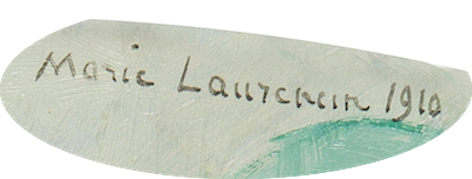

(Paris, 1883 - Paris, 1956)

A classmate of Braque, a muse of Apollinaire, a Matisse disciple, supported by Derain, Picasso's friend until their break up, Marie Laurencin is an iconic character.
In the fall of 1901, receiving a Bachelor among only a few thousand, she intended to become a teacher but betrayed her mother's wishes and enrolled for three years with Pauline Lambert to become a porcelain painter. At the start in 1902, she joined the Humbert Academy where she met Francis Picabia, Georges Braque and Lepape. These companions became his first admirers and encouraged her to abandon the craft, to persevere in the artistic way that her mother disapproved of. Braque quickly noticed the talent of his comrade and integrated her into the circle of Picasso where poets and artists mingled.
In 1907, she exhibited for the first time at Salon des Independants in Paris. In 1912, she exhibited her artworks with Robert Delaunay at the Barbazangues Gallery and participated in the decoration of the Cubist House of the Salon d’Automne. In 1937, during the Great Exhibition of Independent Art Masters (Petit Palais), she presented an exemplary choice of her pieces, including Portraits (1904), Portrait of young woman with black and pink hat (1908), G. Apollinaire and his family – Marie Laurencin in blue (1936), and The Blue Angel (1929). In 1994, the foundation Gianadda (Martigny) presented a retrospective of her artwork.
Marie Laurencin became painter of young woman with deer eyes. She mixed – as many poets did – realism and fantasy. Her model was often her housekeeper’s daughter. The art dealer Paul Rosenberg signed a contract with her and contributed to her renowned reputation with his exhibitions. Her natural tropism inspired her to create a “laurencine” painting, elegant and intensive, which kept with the decorative art style of this time.
Married to a German painter, she left France during the Second World War for Spain, where she met Gleizes, Cravan, Gauthier and Picabia. She returned to Paris in 1920. After the First World War and her Spanish exile, she prefered the company of writers such as Paul Valery, André Gide, Jean Giraudoux, Paul Morand and Alexis Léger rather than artists. In 1923, she realised decors and costumes for The Hinds Ballet by Francis Poulenc. From 1923, she became the official portraitist of personalities such as Coco Chanel. Her art peaked in portrait and embodied, during Golden Twenty, the French refinement of taste. She was the popular portraitist of a society where reigned the Baroness Gourgaud, Countess Etienne de Beaumont and Lady Cunard, surrounded by men such as the smart Jean Cocteau.
Her friendships inspired her numerous variations and self-portraits around an eternal feminine: round dance of young women with timeless figures and pearls or flowers. In her maturity, Marie Laurencin preferred the company of writers rather than painters. She continued to reinvent a world of dreams with poetical freshness. ...